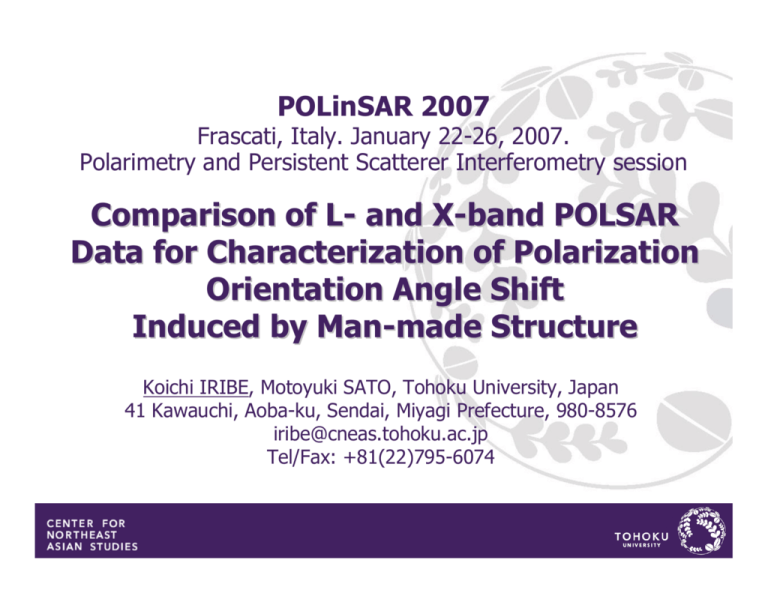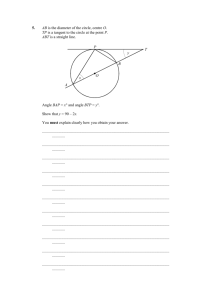Comparison of L- and X-band POLSAR Data for Characterization of
advertisement

POLinSAR 2007 Frascati, Italy. January 22-26, 2007. Polarimetry and Persistent Scatterer Interferometry session Comparison of L- and X-band POLSAR Data for Characterization of Polarization Orientation Angle Shift Induced by Man-made Structure Koichi IRIBE, Motoyuki SATO, Tohoku University, Japan 41 Kawauchi, Aoba-ku, Sendai, Miyagi Prefecture, 980-8576 iribe@cneas.tohoku.ac.jp Tel/Fax: +81(22)795-6074 Shift of Polarization Orientation Angle Induced by Ground Surface Patch Jong-Sen Lee, Dale L. Schuler, et al. The induced polarization orientation angle shift θ is represented, tan θ = − tan ω − tan γ cos φ + sin φ Where tanω is the azimuth slope, tanγ is the range slope, φ is the radar look angle. Induced by Dihedral Structure Hiroshi Kimura, et al. tan θ = − tan α cos φ Where tanα is the target azimuth angle, φ is the radar look angle. Estimation of PO Angleθfrom POLSAR data The Circular Co-Pol method: * θ = ⎡⎣ Arg ( ORR OLL ) + π ⎤⎦ 4 For θ > π 4, replace θ by (θ − π 2 ) Where ORR and OLL represent the observed scattering matrix of RR and LL. Illumination Direction Azimuth Large-scale building X-band, 187.5m*225m, |HH-VV|, |2HV|, |HH+VV| Estimated PO Angle θ Pi-SAR New R&D for monitoring Earth Environment. NiCT and JAXA developed Pi-SAR in 1996. Pi-SAR: Airborne High-resolution Multi-parameter SAR X-band L-band Frequency 9.55GHz 1.27GHz Wave length 3.14cm 23.6cm Resolution 1.5m 3m Observation mode Polarimetry [HH/HV/VH/VV] Interferometry Polarimetry [HH/HV/VH/VV] X-band Main Antenna X-band Sub Antenna L-band Antenna ©NiCT/JAXA Investigation of the frequency dependence. Objective Sendai city, February 12, 2005 Illumination Direction Azimuth L-band X-band The azimuth angle of dihedral structures is an important parameter which represents the characteristics of Urban area. Investigate the properties of PO angles from the view point of wavelength. Polarimetric Analysis of Urban Area Difficulties, such as layover, shadowing, and multi-bounce, etc. In addition, our targets are dihedral structures. A model fit for Urban structures. A Model fit for Urban Structures T. Moriyama, et al., 2005 Polarimetric correlation coefficient S hh S hv* = S hv Svv* = 0 S hh S hv* ≠ 0, S hv Svv* ≠ 0 for natural distributed area. for urban area. Scattering Model (1) Odd-bounce scattering [ S ]Odd ⎡β =⎢ ⎣0 0⎤ , Re( β ) > 0 ⎥ 1⎦ where βis a ratio of HH to VV. (3) Cross scattering [ S ]Cross ⎡γ =⎢ ⎣ρ ρ⎤ 1 ⎥⎦ (2) Even-bounce scattering [ S ]Even ⎡α =⎢ ⎣0 0⎤ , Re(α ) < 0 1 ⎥⎦ where αis a ratio of HH to VV. Wire (Re(γ) >0) or Dihedral structure (Re(γ) <0). ,where γand ρare a ratio of HH and HV to VV. Algorithm * S hh S hh = f Odd β + f even α + f Cross γ 2 2 2 Svv Svv* = f Odd + f even + f Cross S hh S * vv Not zero for Urban area = f Odd β + f evenα + f Cross γ S hv S hv* = f Cross ρ , Shh S hv* = f Cross γρ * , Shv Svv* = f Cross ρ 2 where fOdd, fEven, and fCross are the odd-bounce, even-bounce, and cross scattering contributions to <SvvSvv*>, respectively. If Re( S hv Svv* ) > 0, then α = −1, If Re( S hv Svv* ) < 0, then β = 1. Total power P can be decomposed into the three contributions for each scattering model. P = POdd + PEven + PCross f Even (1 + α ) for Re(γ ) > 0 2 PEven = f Even (1 + α ) + f Cross (1 + γ + 2 ρ ) for Re(γ ) < 0 2 2 2 Dihedral Structures in an Image α ≠0 Target azimuth angle α = 0 500m*500m Intensity of (HH-VV). X-band, HH, HV, VV PEven Extraction of Dihedral Structures HH − VV Pixel Number PEven bounce −2.0[dB] Intensity Value [dB] Right upper figure: Pauli Polarimetric decomposition Image. HH-VV, 2HV, HH+VV. Right lower figure: Binary Image. Threshold: Peven>-2.0[dB] PO Angle Shifts by Dihedral Structures PO Angle Shifts Masked PO Angle Shifts Built-up Area Residential block 1250m*1250m L-band, HH-VV, 2HV, HH+VV Estimated PO Angle θ X-band, HH-VV, 2HV, HH+VV Estimated PO Angle θ Not Built-up Area Large-scale buildings L-band, HH-VV, 2HV, HH+VV Estimated PO Angle θ 500m*500m X-band, HH-VV, 2HV, HH+VV Estimated PO Angle θ Estimation of Target Azimuth Angle α Conversion of PO angleθto target azimuth angleα: α = tan −1 ( − cos φ tan θ ) ,where φ is the radar look angle. Radar look angle φ = 40.5(deg) L-band, Window Size is 3*3 pixels. X-band, Window Size is 3*3 pixels. αmeasure = 23.6(deg) αmeasure = 12.3(deg) αmeasure = 39.3(deg) αmeasure = −1.5(deg) Estimated target azimuth angleα(deg) Comparison of Measured and Estimatedα L-band x X-band Measured target azimuth angleα(deg) Low accuracy for larger target azimuth angleα. Since the resolution of L- and X-band is 9m and 4.5m respectively, (window size is 3*3 pixels) X-band is effective for wider range estimation of α? Summary • The azimuth angle of man-made structure is an important parameter which represents the characteristics of Urban environment. • We focused on PO angle shifts induced by dihedral structure formed by a vertical wall and the ground. • We estimated the target azimuth angle from PO angle shift, and investigated the accuracy of the estimation from the view point of wave length. • As for the estimation of azimuth angle of large-scale buildings, X-band data of 3*3 pixels window size shows good accuracy. • We will change the target and the window size for averaging.





